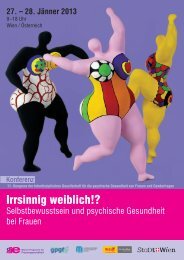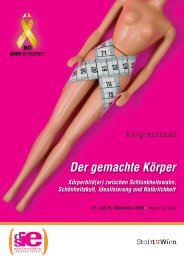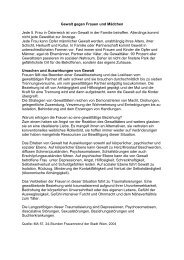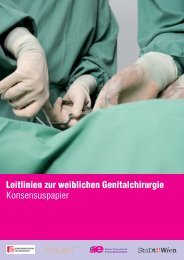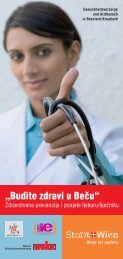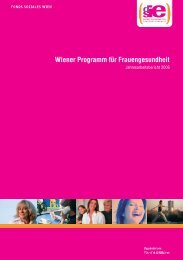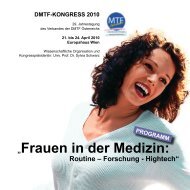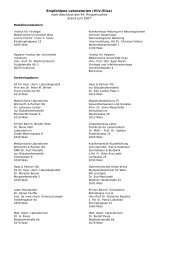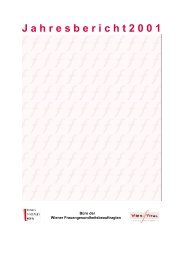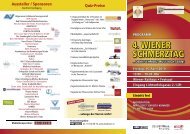Forschung Migration und Gesundheit im Rah - Bundesamt für ...
Forschung Migration und Gesundheit im Rah - Bundesamt für ...
Forschung Migration und Gesundheit im Rah - Bundesamt für ...
Create successful ePaper yourself
Turn your PDF publications into a flip-book with our unique Google optimized e-Paper software.
However, after much discussion among the research team<br />
members, we came to the conclusion that physicians (especially<br />
private physicians) would probably be unwilling or unable<br />
to take t<strong>im</strong>e out of their busy schedules to conduct consultations<br />
with standardized patients. In order to address our study<br />
objectives we need each physician to conduct several consultations,<br />
which would represent a considerable t<strong>im</strong>e commitment<br />
on their part. We felt that the heavy investment in<br />
terms of t<strong>im</strong>e and resources (training of standardized patients,<br />
scheduling of consultations, filming and analysis of consultations,<br />
etc.) would not be justified if we did not recruit a min<strong>im</strong>um<br />
of 100 physicians, which seemed unlikely.<br />
Therefore, even though we felt that standardized patients represented<br />
a more valid method for evaluating physicians’ cultural<br />
competence skills, we decided to explore the possibility<br />
of incorporating our clinical scenarios into a s<strong>im</strong>ulated patient<br />
program. These are interactive, computer-based programs that<br />
present a clinical situation to the physician, who must then ask<br />
questions to the “patient”, and make decisions based on the answers<br />
provided. Such programs can record the formulation and<br />
sequencing of questions asked by the physician, thus allowing<br />
us to evaluate whether the physician has addressed the particular<br />
themes we are interested in.<br />
The s<strong>im</strong>ulated patient programs are less realistic than standardized<br />
patients, and technical l<strong>im</strong>itations of the programs mean<br />
that the skills assessment will be narrower than what would be<br />
possible with standardized patients. However, the advantage of<br />
this approach is that physicians can access the patient scenarios<br />
at their convenience via Internet – in their homes, offices or at<br />
the hospital. We hope that this flexibility will help increase our<br />
recruitment of physicians.<br />
We are currently working with a Swiss developer, VIPS„ (Virtual<br />
Internet Patient S<strong>im</strong>ulator) to incorporate our scenarios into their<br />
patient data base.<br />
2.2 Administration of the two research tools<br />
During February till April 2006, the cultural competence questionnaire<br />
will be administered to:<br />
a random sample of 600 physicians working at the Geneva<br />
University Hospital<br />
a random sample of 600 private physicians working in Geneva<br />
250 Geneva medical students (all 4th-, 5th- and 6th-year<br />
students)<br />
Once initial analyses have been conducted, we will recruit a<br />
representative sample of approx<strong>im</strong>ately 200 physicians who<br />
responded to the questionnaire, and invite them to conduct<br />
s<strong>im</strong>ulated patient consultations (medical students will not<br />
be recruited for this phase of the research). For each s<strong>im</strong>ulated<br />
patient consultation, a score will be generated based on<br />
whether key topics were addressed, and whether the information<br />
provided or question asked was formulated appropriately<br />
(open- vs. closed-ended questions; non-technical language,<br />
etc.). Associations between questionnaire and s<strong>im</strong>ulated patient<br />
scores will be explored.<br />
36<br />
3 Results<br />
The project is on-going at this t<strong>im</strong>e (February 2006). In this<br />
section we highlight key findings from the literature review<br />
which influenced the development of our questionnaire, and<br />
describe the main features of the questionnaire.<br />
3.1 Findings from the literature review<br />
The most commonly quoted definition of cultural competence<br />
is that proposed by Cross et al. (1989): “a set of congruent behaviors,<br />
attitudes and policies that come together in a system,<br />
agency or among professionals that enables effective work<br />
in cross-cultural situations”. Cultural competence can operate<br />
at the level of the health service (structures and processes),<br />
or at the level of the individual clinician, and is fo<strong>und</strong>ed on<br />
the recognition of the <strong>im</strong>portance of culture in people’s lives,<br />
respect for cultural difference, and a commitment to min<strong>im</strong>ize<br />
any negative consequences of cultural difference. Our study is<br />
specifically interested in physician-level cultural competence,<br />
which can be <strong>und</strong>erstood as the ability to provide patient-centered,<br />
culturally sensitive care to patients from diverse backgro<strong>und</strong>s.<br />
Many professional organizations in different areas of health<br />
have developed policies and guidelines that define and promote<br />
culturally competent practices by physicians. There are<br />
also a number of examples in the medical literature of pregraduate<br />
and postgraduate training activities a<strong>im</strong>ed at increasing<br />
clinicians’ cultural competence. Based on our review of<br />
these materials, there seems to be general agreement among<br />
experts with regards to the general attitudes, knowledge and<br />
skills that learners should possess in order to be able to deliver<br />
high-quality care to diverse populations. These include:<br />
attitudes: respect and tolerance for social/cultural differences;<br />
awareness and self-reflection regarding one’s own culture<br />
and biases; acceptance by the clinician of his or her responsibility<br />
to <strong>und</strong>erstand and respond to cultural aspects of health<br />
and illness; and willingness to make their own clinical settings<br />
more accessible to patients by taking into consideration social<br />
and cultural factors.<br />
general knowledge: basic social science concepts such as<br />
culture and the illness/disease distinction; an <strong>und</strong>erstanding of<br />
how culture influences health, illness and health care; awareness<br />
of social and cultural barriers to health care; sources of<br />
cross-cultural mis<strong>und</strong>erstandings; awareness of cross-cultural<br />
communication approaches for bridging patient/provider differences.<br />
skills: effective collaboration with translators; approaches<br />
for eliciting the patient’s <strong>und</strong>erstanding of the illness and determining<br />
the patient’s social context; negotiation of treatment<br />
and referral plans with patients and families that incorporate<br />
social and cultural issues; collaboration with other health and<br />
social resources.<br />
However, while there appears to be general agreement about<br />
the core attitudes, knowledge and skills that culturally competent<br />
physicians should possess, it is unclear what training<br />
approaches are most effective for reaching these objectives.<br />
Betancourt (2003) identified three main approaches to teaching<br />
cross-cultural medicine: the awareness/sensitivity approach<br />
which focuses on developing attitudes; the categorical ap-



